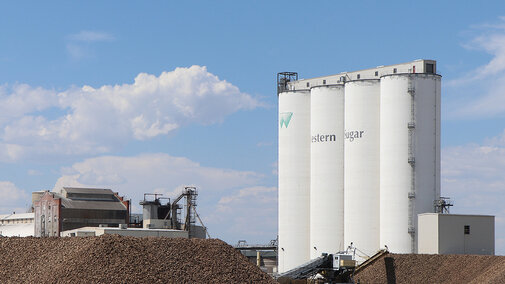Western Sugar began its early harvest on Sept. 2, and sugar beets are beginning to pile up in the yard before heading into the factory for slicing and processing.
“We’ve been running for a day and a half, and our sugar content is 15.4 — a record high for this time of year,” said Jerry Darnell, vice president of agriculture, south region for Western Sugar.
He contributed the high sugar content to some good growing degree days, the herbicide Goltix, and sugar beet seed CR+, which helped with Cercospora.
While the temperatures are typical for this time of year, the days can still hit the 90s, which is not great for the sugar beets. Yet, Darnell said they are not worried.
“In early harvest, we control the purchasing and slicing of the beets, so it’s (heat) not an issue,” he said. Western Sugar and the growers will look for cooler weather when the regular harvest begins in October. “For the regular harvest, we’re estimating sugar content of 18.8 and 31 tons per acre.”
The other crops in the Panhandle include dry edible beans. Those that didn’t get hailed on in the early spring are beginning to turn, and some have been harvested. The corn is beginning to dent fully.
“Some winter wheat has been planted in the dryland areas of the Panhandle,” said Gary Stone, Nebraska Extension water and cropping systems educator. “The millet fields are beginning to turn and will be harvested soon.”
Irrigation water deliveries for the North Platte Valley include Pathfinder diverting approximately 1,700 cfs and Goshen/Gering-Fort Laramie irrigation district diverting approximately 1,375 cfs. Seminoe Reservoir is at 57 percent capacity, Pathfinder Reservoir is at 57% capacity, and Glendo Reservoir is at 30% capacity.
Assisting growers with monitoring their crop's water profile is the estimated crop water use for Sept. 2-8. The table information includes the estimated crop water use for Nebraska Panhandle crops for the previous week and the upcoming week. The table is based on data gathered and calculations made by Gary Stone, Nebraska Extension educator, and Dr. Xin Qiao, extension irrigation and water management specialist, both based at the UNL Panhandle Research and Extension Center in Scottsbluff, Nebraska.
Crop water use will vary across the Panhandle due to variations in ET, crop growth stage, temperature, soil type, wind and precipitation events. Crop water use will assist growers with irrigation scheduling and efficient water application and use.
Register online to receive a weekly text message with the table information.
The AgriTools App can provide easy access to location-specific climate and weather information to the agricultural industry in Nebraska.


